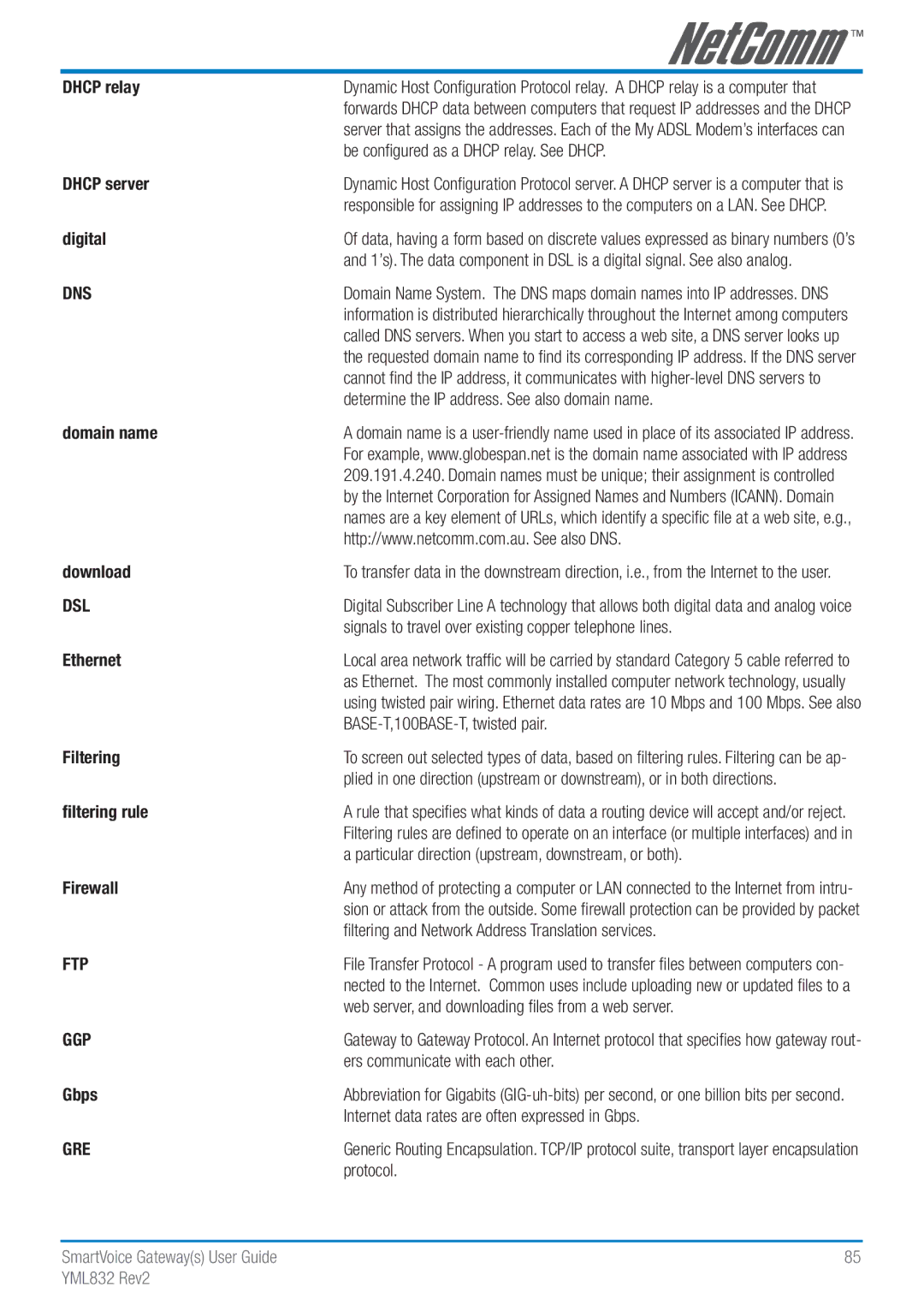DHCP relay | Dynamic Host Configuration Protocol relay. A DHCP relay is a computer that |
| forwards DHCP data between computers that request IP addresses and the DHCP |
| server that assigns the addresses. Each of the My ADSL Modem’s interfaces can |
| be configured as a DHCP relay. See DHCP. |
DHCP server | Dynamic Host Configuration Protocol server. A DHCP server is a computer that is |
| responsible for assigning IP addresses to the computers on a LAN. See DHCP. |
digital | Of data, having a form based on discrete values expressed as binary numbers (0’s |
| and 1’s). The data component in DSL is a digital signal. See also analog. |
DNS | Domain Name System. The DNS maps domain names into IP addresses. DNS |
| information is distributed hierarchically throughout the Internet among computers |
| called DNS servers. When you start to access a web site, a DNS server looks up |
| the requested domain name to find its corresponding IP address. If the DNS server |
| cannot find the IP address, it communicates with |
| determine the IP address. See also domain name. |
domain name | A domain name is a |
| For example, www.globespan.net is the domain name associated with IP address |
| 209.191.4.240. Domain names must be unique; their assignment is controlled |
| by the Internet Corporation for Assigned Names and Numbers (ICANN). Domain |
| names are a key element of URLs, which identify a specific file at a web site, e.g., |
| http://www.netcomm.com.au. See also DNS. |
download | To transfer data in the downstream direction, i.e., from the Internet to the user. |
DSL | Digital Subscriber Line A technology that allows both digital data and analog voice |
| signals to travel over existing copper telephone lines. |
Ethernet | Local area network traffic will be carried by standard Category 5 cable referred to |
| as Ethernet. The most commonly installed computer network technology, usually |
| using twisted pair wiring. Ethernet data rates are 10 Mbps and 100 Mbps. See also |
| |
Filtering | To screen out selected types of data, based on filtering rules. Filtering can be ap- |
| plied in one direction (upstream or downstream), or in both directions. |
filtering rule | A rule that specifies what kinds of data a routing device will accept and/or reject. |
| Filtering rules are defined to operate on an interface (or multiple interfaces) and in |
| a particular direction (upstream, downstream, or both). |
Firewall | Any method of protecting a computer or LAN connected to the Internet from intru- |
| sion or attack from the outside. Some firewall protection can be provided by packet |
| filtering and Network Address Translation services. |
FTP | File Transfer Protocol - A program used to transfer files between computers con- |
| nected to the Internet. Common uses include uploading new or updated files to a |
| web server, and downloading files from a web server. |
GGP | Gateway to Gateway Protocol. An Internet protocol that specifies how gateway rout- |
| ers communicate with each other. |
Gbps | Abbreviation for Gigabits |
| Internet data rates are often expressed in Gbps. |
GRE | Generic Routing Encapsulation. TCP/IP protocol suite, transport layer encapsulation |
| protocol. |
|
|
SmartVoice Gateway(s) User Guide | 85 |
YML832 Rev2 |
|
